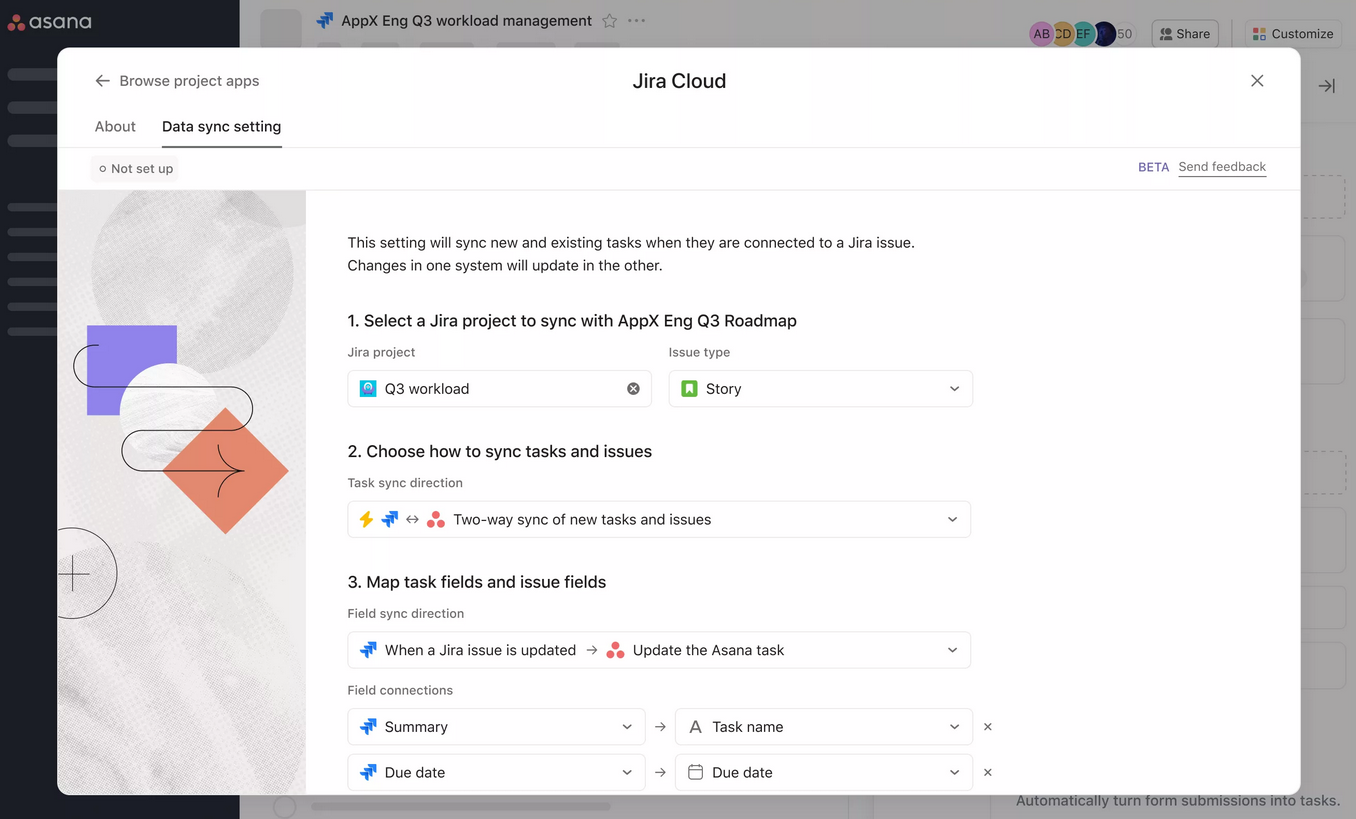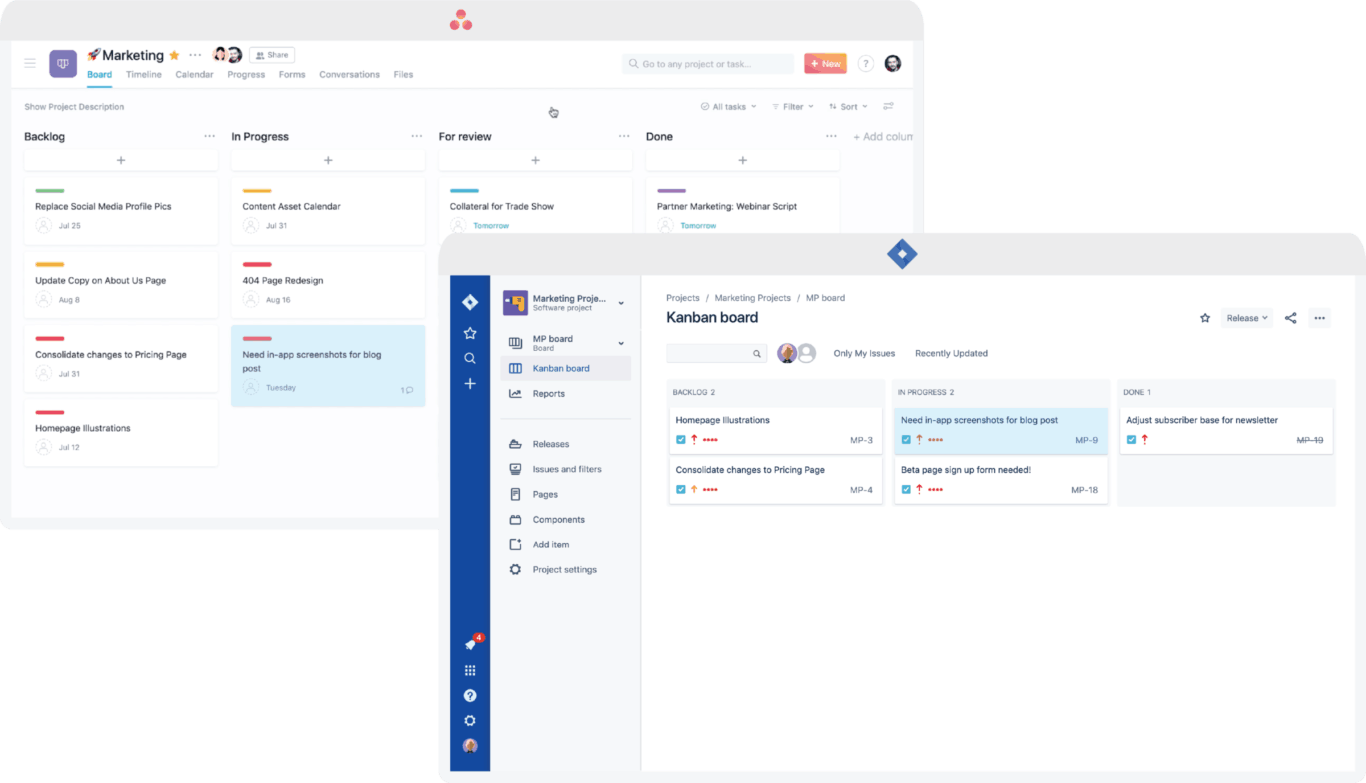Asana’s Native Jira Integration: A Comparison With Unito
If you’ve been an avid Asana user for a while, you might know that the team behind the tool also offers a Jira Cloud integration — exciting news for Asana users who work closely with developers.
Unito also provides an Asana and Jira integration — one that covers Cloud and on-premise instances. Here’s a look at the functionality and uses cases for both, so you can make an informed decision on which integration is right for you.
| How we compare | Asana’s Native Jira Integration | Unito |
| Ease of use | Easy | Easy |
| Sync and automation | 1-way (2-way only available for some Asana plans) | 2-way |
| Customizability | Limited | Extensive |
| Subtasks, Comments, Attachments | No | Yes |
| Supported fields | Less | More |
| Integrations | Asana→Jira | Asana, Jira, and 40+ other tools |
| Versions supported | Jira Cloud | Jira Cloud, Jira Servier, Jira Service Management |
What is Asana for Jira Cloud Data Sync?
This Asana→Jira sync is an integration built by the team at Asana, and it’s available for users with Advanced and Enterprise plans. A more limited version, which only creates Asana tasks from Jira issues, is available for Standard users.
This integration allows you to build a two-way sync between Asana and Jira Cloud, automatically creating new work items to keep each tool up to date. That means creating new issues in Jira can create new tasks in Asana and vice versa. The Asana for Jira Cloud Data Sync also keeps designated fields in these work items in sync.

Setting up this integration between Asana and Jira is as simple as adding it to the Asana project you want to sync tasks from, connecting it to the appropriate Jira project, and specifying the fields you want to sync. This allows Asana users to keep an eye on the work engineering and technical teams are doing in Jira.
Asana for Jira Cloud Data Sync use cases
With this native Jira integration, tasks and issues stay completely in sync, making software development projects more visible to teams in Asana. It also means less copying and pasting information from one task into another to keep people informed. This may also mean fewer emails and meetings between business and technical teams.
In terms of specific use cases, Asana highlights the following:
Status updates for sales and customer success teams
The real-time updates to the status field allow sales teams and customer success teams to move on deal opportunities faster, keep training materials updated, and provide customers with previews of new features.
Progress tracking for product leads
After product leads hand off development projects, they’re able to track the status of the work from within their own Asana tasks.
More transparent development
With this new integration, developers can link their Jira issues to roadmaps and projects in Asana to keep non-technical teams looped in. They can also more easily share progress on product launch plans or web mockups.
Unito’s Asana-Jira integration

In addition to increased visibility, Unito’s Asana-Jira integration empowers cross-functional collaboration. Unito allows Asana and Jira users to work together on projects, from start to finish, without leaving their tool of choice. Our two-way sync functionality allows nearly any changes you make to an Asana task to be automatically reflected in the associated Jira issue, and vice versa. They become connected on a functional level, with overlapping workflows and field matching.
Unito can sync the following fields:
| Asana | Jira | |
| Task Title | ←→ | Issue Title |
| Task Description | ←→ | Issue Description |
| State | ←→ | State |
| Comments | ←→ | Comments |
| Assignees | ←→ | Assignees |
| Tags | → | Labels |
| State | ←→ | Status |
| Due Date | ←→ | Due Date |
| Attachments | → | Description Footer |
| Description Footer | ← | Attachments |
| Description Footer | ← | Link to Issue |
| Custom Fields | ←→ | Custom Fields |
| Link to Task | → | Description Footer |
| Description Footer (or Custom Field) | ← | Priority |
| Custom Field | → | Description Footer |
| Description Footer (or Custom Field) | → | Issue Type |
| Created By | → | Description Footer |
| Description Footer | ← | Reporter |
| Description Footer (or Custom Field) | ← | Epic Name |
| Description Footer (or Custom Field) | ← | Original Estimated Duration |
Unlike the native integration, Unito’s integration can create tasks and issues based on your specifications. Only want a new issue created in Jira when a specific assignee is added to the relevant Asana task? You can do that. Trying to keep things clean and only want work items with specific labels syncing over? You can do that too.
Unito’s Jira integration can be used by Asana users on any plan, and covers both Jira cloud and on-premise instances.
Unito’s Asana→Jira integration use cases
Anything development-related that used to force your team out of Asana can now be done in that tool you know and love. You also gain visibility not just on the task level, but on the project level, enabling better reporting and opportunities for optimization. Top use cases for the Unito integration include:
Cross-team collaboration on development projects
How many of your teams depend on developers for support? Instead of making sales, marketing, or customer service teams jump into Jira issues, let them stay in the tools they know and love. Make a development request in Asana and it will sync directly to Jira as an issue. All fields update automatically as they change. Track progress from either tool or chat with a developer within the Asana task comments. Entire cross-functional projects can be completed without forcing teams to leave their tool, saving substantial time and effort. This can also eliminate unnecessary meetings and emails.
Curious to see how it works? Here’s how a department at the University of Oregon uses Unito’s Jira to Asana integration to keep project managers and software developers in the loop.
High-level roadmaps
A project manager’s day-to-day might happen in Asana rather than Jira, even if they’re in charge of a development team. With Unito, a project manager can create an Asana project to serve as a roadmap of all development efforts and sync multiple Jira projects to it. Because Unito syncs issue status, comments, attachments, and more, a project manager can keep their eye on every Jira project they’re responsible for — and communicate with their team — without leaving Asana.
Providing clients with project updates
Create an Asana project for a client and sync it to your development team’s Jira project to give them direct access to your progress. This gives clients the ability to communicate their feedback and requests to your team directly, rather than having it be distorted through multiple channels. Plus, you can use rules to keep sensitive information confidential and still give clients access to what they need to know.
Which integration should you pick?
Each Jira→Asana integration supports two-way syncing of data between tools. Both will let you turn Jira issues into Asana tasks and vice versa. Both will keep your work items up to date. So which one’s right for you?
While the Jira Cloud integration built by Asana has some advantages — like being able to set it up without leaving Asana — it’s likely not the best option for most of your workflows. Here’s why Unito has the stronger Jira integration for Asana.
- It supports more fields: While both integrations can sync a staggering amount of fields, Unito’s integration supports some that Asana’s integration doesn’t, like Labels, Attachments, and Epics.
- It covers all versions of Jira: Asana’s integration only supports Jira Cloud, meaning that any larger organizations with on-premise installations won’t be able to use it. Unito’s integration works with both Jira Cloud and Jira Data Center.
- It covers more tools: What if you don’t just need to sync Asana to Jira Cloud? Maybe you want your Asana tasks sent automatically to a spreadsheet or you need Jira issues to sync seamlessly with development work in GitHub. Only Unito can get you that same two-way sync functionality across more than 30 tools.
Want to see how easy it is to set up a Unito integration between Asana and Jira? Check out our full walkthrough here.
Asana-Jira sync FAQ
Can Jira sync with Asana?
Yes, there are multiple ways to sync Jira with Asana. While Jira doesn’t have a built-in integration to sync data with Asana, there is one built into Asana.
Beyond this integration, you can use third-party apps like Unito that support syncing Jira with Asana and other tools.
How do I import data from Asana to Jira?
You can import data from Asana into Jira in a few ways:
- Exporting Asana data as a CSV file and import the file into Jira.
- Using Asana’s built-in Jira integration to sync data between the two tools in both directions and automatically create both tasks and issues.
- Using Unito’s 2-way sync for Asana and Jira, which also supports syncing data to other tools.
Does Asana have a Jira integration?
Asana offers a built-in integration with Jira with a two-way sync, though this is only available for Advanced and Enterprise plans. This allows you to sync data from Asana tasks to Jira issues and back without leaving Asana.
Can Asana sync with other tools?
Asana also offers a native Salesforce integration, allowing users to automate the transfer of data between the two tools.


